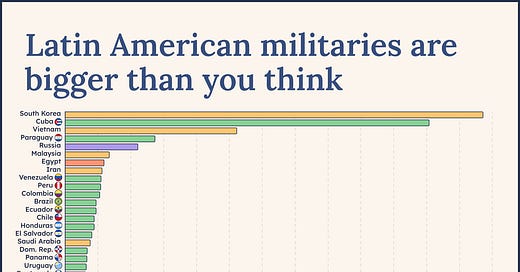🪖 Militaries
The surprising size of Latin American armed forces, and a look at their spending patterns.
Welcome to Latinometrics. We bring you Latin American insights and trends through concise, thought-provoking data visualizations.
📢 Showcase your brand to Latinometrics’ 21K+ engaged readers. Book ad space.
Military Spending 🎖️
Latin America is far from perfect. From inequality to crime to sluggish productivity, the region’s got its fair share of challenges.
But in a time of wars in Ukraine and the Middle East, in a time of military tensions between China and Taiwan or Armenia and Azerbaijan, the lack of interstate conflict in Latin America is certainly commendable.
Diplomatic spats, like Ecuador versus Mexico or Argentina versus Colombia or basically everybody versus Venezuela? Sure, that’s an ordinary Tuesday. But regional countries haven’t actually fought a war over, say, territorial sovereignty since the Cenepa War fought between Ecuador and Peru in early 1995. That’s nearly 30 years ago now.
Which begs the question why some Latin American countries have got such bloated militaries.
Sure, there are countries like Costa Rica, which abolished its standing army in 1948 and today just maintains a smaller military-like security force. But looking to countries in the rest of the region, we see some relatively large armed forces. Cuba, for example, has over a tenth of its population affiliated in some way with the military, despite not being at war.
And if you think “Well, look at Cold War history to understand that” – what about Paraguay? Why is there a bigger share of Paraguayans, which haven’t fought a war since the 1930s, serving than Russians who are currently fighting their neighbor?
Especially because military maintenance is no cheap affair. As our next chart shows, there’s a logic to who is spending the most on their armed forces.
Keep reading with a 7-day free trial
Subscribe to Latinometrics to keep reading this post and get 7 days of free access to the full post archives.




